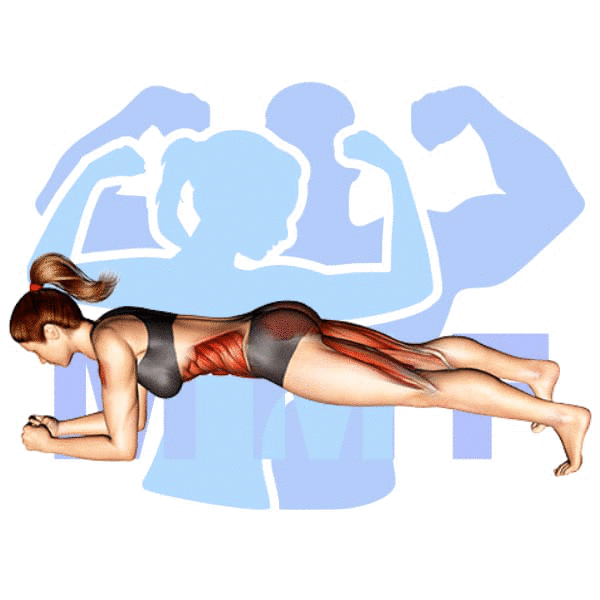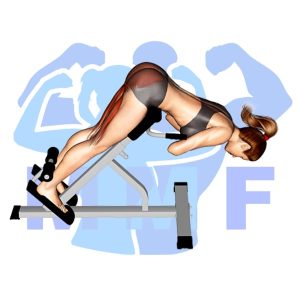Are you tired of back pain and discomfort in your hip muscles? Are you struggling to find an exercise that targets these areas effectively? Look no further than the plank hip lift. It’s a common issue for many people to experience aches and pains in the lower back and hips due to a sedentary lifestyle or even sitting at a desk for prolonged hours. However, the plank hip lift can be a simple yet effective solution to these problems. In this blog post, we will guide you through the proper form and technique of the plank hip lift and explain the benefits of incorporating this exercise into your daily routine. Say goodbye to discomfort and pain, and hello to a stronger, healthier you!
Plank Hip Lift Summary
- Primary Muscles: Rectus Abdominis
- Secondary Muscles: Iliopsoas (Psoas Major & Iliacus), Obliques, Pectoralis major, Quadriceps, Sartorius, Serratus Anterior, and Tensor Fasciae Latae
- Equipment: Body Weight
- Mechanics Type: Compound
- Force: Pull
- Utility: Basic

Plank Hip Lift Instructions
- Begin by finding a surface with good support for your elbows and lay down while supporting yourself on your elbows and your toes.
- Then bring your hips up so your torso and your legs are at a 90-degree angle and hold.
- Continue to hold to work your core.
Video Tutorial
Plank Hip Lift Muscles
Target (Agonist)
Synergists
- Iliopsoas (Psoas Major & Iliacus)
- Obliques
- Pectoralis major
- Quadriceps
- Sartorius
- Serratus Anterior
- Tensor Fasciae Latae
Dynamic Stabilizers
- None
Stabilizers
- None
Antagonist Stabilizers
- None

Benefits of Plank Hip Lift
The Plank Hip Lift is an excellent exercise for strengthening the Rectus Abdominis, which is the main abdominal muscle that runs from the sternum to the pubic bone. This exercise engages the core muscles, including the Rectus Abdominis, to stabilize the body while lifting and lowering the hips. Performing this exercise regularly can help build a strong core, improve posture, and reduce risk of back injury. Additionally, this exercise also helps target and strengthen the hip flexors and gluteal muscles, which can help to improve balance and coordination.
Tips for Performing Plank Hip Lift
Your at the right place if you’re motivated to enhance your plank hip lift execution. Using these suggestions can allow you to maximize the advantages of this beautiful exercise. Concurrently with shaping your stomach muscles, increasing movability, and also a reduced chance of injury can all be accomplished with this exercise. Let’s start now and see what these tips may accomplish for you.
- Keep your core engaged: Make sure your core is engaged throughout the entire exercise to get the most out of it. This will help you stay balanced and maximize the benefit of the exercise.
- Keep your back straight: Make sure your back is straight, not arched or rounded, to help keep your spine in proper alignment. This helps to avoid any strain or injury and maximize the effectiveness of the exercise.
- Breathe: Remember to take deep breaths throughout the exercise, as this helps to keep your body relaxed and get the most out of the exercise. Additionally, proper breathing helps to keep your core engaged and your body in proper alignment.
Benefits and Tips Video
Frequent Mistakes To Avoid
When executing plank hip lift, avoiding typical errors is usually the difference between an effective workout and a debilitating injury. Additionally, achieving the most out of the exercise requires proper form, and avoiding perform typical errors can allow you to perform the exercise correctly and obtain optimal results. But relax, it’s not as challenging as it might seem. By knowing the errors to avoid and taking the appropriate actions, you can execute the activity safely and effectively. So let’s get started on avoiding those common mistakes and making this exercise a normal part of your fitness training.
- Not engaging the core: Many people forget to tighten their core muscles when doing the Plank Hip Lift, which means that they are not getting the full benefit of the exercise. This means that the exercise won’t help tone or slim your body as effectively as it could.
- Not keeping the hips level: If you fail to keep your hips level throughout the movement, you won’t be able to target and work the correct muscles, reducing the effectiveness of the exercise.
- Moving too quickly: Moving too quickly through the Plank Hip Lift can cause you to lose your form, which in turn can lead to a less effective workout. It is important to take your time and focus on your form to get the most out of this exercise.
Find More Bodyweight Exercises Here
Variations and Complementary Exercises
If you’re looking for variations, complementary, or alternative exercises that are similar to the Plank Hip Lift, you’ve come to the right place. Here are a few exercises that can be used as substitutes for Plank Hip Lift that will still help you target the same muscles.
Plank

The Plank is an excellent complementary or alternative exercise for the Plank Hip Lift. It is a bodyweight exercise that strengthens and tones the core, shoulders, and legs, while also engaging the back muscles. The Plank works to stabilize the body as it holds a static position for an extended period of time, allowing the abdominal muscles to be strengthened and toned. This exercise also helps to improve balance and posture, which can help to prevent lower back pain. The Plank can be used in conjunction with the Plank Hip Lift or as a stand-alone exercise for those who are looking for an effective core workout.
Lying Straight Leg Raise

The Lying Straight Leg Raise is an effective exercise for strengthening the core and lower body muscles, and it can be used as a complementary or alternative exercise to the Plank Hip Lift. This exercise works the hip flexors, hamstrings, glutes, and abdominals, and it is a great way to increase stability in the core. It also helps to improve balance and coordination. The Lying Straight Leg Raise can be done by lying flat on the ground with both legs extended and then lifting one leg off the ground until it is parallel to the floor. This exercise should be done slowly with control and can be performed in both directions for maximum benefit.
Lying Alternating Leg Raises

Lying Alternating Leg Raises are an excellent exercise to supplement the Plank Hip Lift. This exercise targets the lower abdomen, helping to strengthen the core and improve posture. It is also great for toning the lower body, as it requires both strength and control. To perform this exercise, begin by lying flat on your back with your legs extended straight up in the air. Then, slowly lower one leg at a time while alternating them. This exercise will increase stability in the core, while also providing a great workout for the hips and legs. With regular practice, this exercise will help to improve posture, balance and overall core strength.
Check Out These Top Bodyweight Exercises
Lever Lying Crunch (Machine)

The Lever Lying Crunch is a great alternative or complementary exercise to the Plank Hip Lift. It works the same core muscles and helps to strengthen the lower abdominals and obliques. This machine uses a footplate and handles that you can adjust to your desired resistance level, which helps to ensure you are targeting the correct muscles. The range of motion is adjustable, so you can increase or decrease the intensity depending on your fitness level. The Lever Lying Crunch is a great way to tone and strengthen your abs and help support your spine when performing other exercises.
Legs Up Crunch

Legs Up Crunch is a great complementary or alternative exercise for the Plank Hip Lift. It targets the same muscles as the Plank Hip Lift, but in a different way. To do the Legs Up Crunch, you start in a seated position and then lift your legs up in the air while crunching your torso up at the same time. This exercise works your core and lower body muscles, while also providing an intense cardio workout. It is a great way to add variety to your workout routine and to target those same muscles you would target with the Plank Hip Lift.
Leg Raise Hip Lift

The Leg Raise Hip Lift is a complementary or alternative exercise to the Plank Hip Lift. This exercise works the same muscles as the Plank Hip Lift, but in a different way. It involves lying on your back, with your legs straight, and lifting your hips up off the ground as you raise your legs to a 90-degree angle. This exercise focuses on strengthening the core and glutes while also engaging the hamstrings and lower back muscles. It is an excellent way to target all the same muscle groups as the Plank Hip Lift while providing a new challenge.
Find More Abs Exercises Here
Opposing Complementary Exercises
To further strengthen the muscles worked in the Plank Hip Lift, it is essential to focus on exercises that work opposing muscle groups. This will help to create a balanced strength, while helping to prevent injury. The following exercises are excellent complements to the Plank Hip Lift:
45 Degree Hyperextension

The 45 Degree Hyperextension is a great complement to the Plank Hip Lift exercise as it works the opposing muscle group. This exercise focuses on strengthening the back muscles, while the Plank Hip Lift works the core muscles. The 45 Degree Hyperextension begins by lying face down on a hyperextension bench with the hips bent at a 45 degree angle. The user then lowers their body until their hips are below the bench and holds for a few seconds before returning to the starting position. This exercise helps to strengthen and stabilize the lower back and is a great way to prevent lower back pain or injury.
Straight Leg Cable Pull Through

The Straight Leg Cable Pull Through is a great way to complement the Plank Hip Lift exercise. This exercise works the opposing muscle group of the hip flexors used in the Plank Hip Lift, focusing on the glutes and hamstrings. The cable pull through allows for a controlled range of motion and emphasizes proper form, making it a great way to further engage the lower body. It also works the core, helping to strengthen the abdominal muscles that are used in the Plank Hip Lift. With a combination of these two exercises, you can effectively target both the hip flexors and glutes, providing a complete workout for the lower body.
Bird Dog Plank

Bird Dog Plank is a complementary exercise to Plank Hip Lift as it works the opposing muscle group. Bird Dog Plank targets the core, glutes, and hamstrings while Plank Hip Lift targets the abs and lower back. By alternating between the two exercises, you can work the entire core and develop better balance and stability. Bird Dog Plank also helps to strengthen the lower body, improving posture and preventing injuries.
Stronger Core, Healthier Body: Master the Plank Hip Lift Today!
Building up a strong core is critical for overall health and fitness. Not only does having a strong core help you to perform better in other exercises, but it also helps to reduce the risk of injury while doing everyday activities. That’s why we’re here to introduce you to the plank hip lift, a challenging move that fires up multiple muscle groups in your core, including your abs, obliques, and lower back. Incorporating this exercise into your regular workout routine will pave the way for a healthier, stronger body.
References: Wikipedia | ExRx.net | PubMed.gov | Comprehensive List of Abs Bodyweight Exercises

